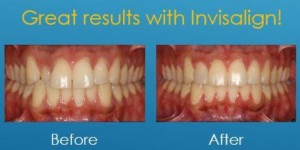How Invisalign Works:
Invisalign is an alternative to braces that uses a series of plastic aligners to move teeth. We start with a virtual model of your teeth, and then program individual movements, in small increments, until an ideal virtual bite is achieved. We then plan what is called “overtreatment”, which exaggerates certain movements to compensate for the jawbones’ resistance and the plastic aligners’ inherent limitations. From start to finish, there will be a certain number of steps or stages, based upon what is known to be a reasonable rate of tooth movement. The aligners are produced from stage in the treatment design process. There can be a wide range of number of aligners in the series from start to finish, but they usually number in the teens to mid-twenties. The aligners are changed at intervals from 7 to 14 days, and the orthodontist will check your progress periodically, and make changes to the process as needed.
Benefits of Invisalign
- They are clear and minimally noticeable to others
- They allow gentle and more comfortable tooth movement
- You take them out to eat, drink, brush, and floss, so there are less dietary limitations vs. braces
- There are minimal extra comfort or repair visits to the orthodontist
- Certain tooth movements are more efficient than with braces

Limitations & Ways Around Them
Overtreatment was discussed in the first section. In some challenging cases treatment must begin with braces, either full or limited, and then the patient can be switched to Invisalign. In other cases, a limited number of braces may be needed in conjunction with Invisalign aligners. In other situations, elastic chains or rubber bands must be worn, just as you often see with standard braces. An important part of Invisalign treatment is the strategic placement of “attachments“, which are small tooth-colored shapes that are bonded to the teeth. When the aligners snap onto the attachments they allow for more control of the teeth and more accurate placement of forces. Keep in mind that treatment usually requires more than one series of aligners. The first series gets the teeth close, and then one or more refinement series are used for finishing of the bite.
How To Select An Invisalign Doctor
Invisalign is in essence another means of performing orthodontic treatment. While all dentists can perform orthodontic treatment, an orthodontist has received 2-3 years of specialty training beyond dental school, and they dedicate their entire career and practice to orthodontic treatment. It cannot be overly stressed how important proper orthodontic diagnosis and treatment planning is to the success of an Invisalign case. Beyond that, it takes much experience to learn how to optimize tooth movement with plastic aligners, and very often proper Invisalign treatment requires help from the standard items in the orthodontist’s tool chest. My recommendation is that you seek an orthodontist who has significant experience treating patients with aligners, and one who has taken much advanced training. A good Invisalign doctor takes and analyzes a full set of orthodontic records, and is willing to go the extra mile to achieve proper results.
And finally, what if you were told that you aren’t a good candidate for Invisalign treatment?
No treatment is right for everyone, and your specific situation may be best addressed with braces rather than Invisalign. Factors beyond your specific situation include the doctor’s judgment, experience with aligners, and training. If you are told that you aren’t a good candidate for Invisalign treatment, seeking another opinion may be in order. Ask if you can be started with braces and switched to aligners once your teeth are within your doctor’s Invisalign comfort zone. In the end, your treatment lasts one to two years, but you have to live with the results. While I quite frequently recommend Invisalign treatment to my patients, I put results ahead of the process.


